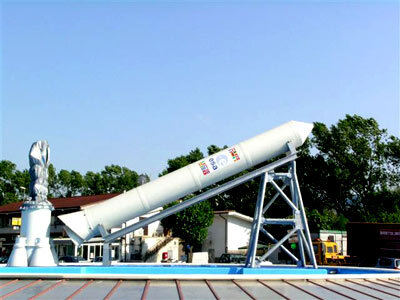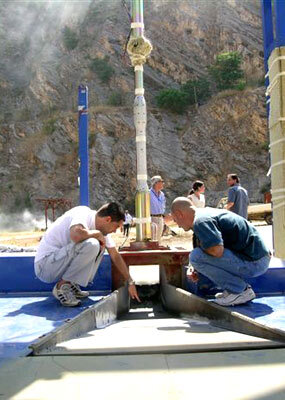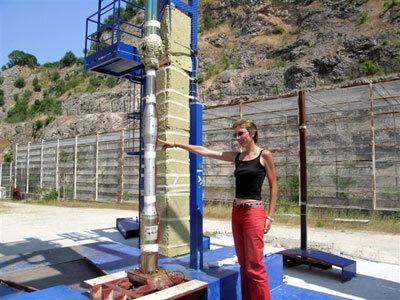Listening to Vega
On a humid day in June, with a temperature similar to that at Europe’s Spaceport in French Guiana, the engine of a miniature Vega launcher was ignited at Colleferro, a small town in the middle of Italy. The reason: to test the noise level.
Why Colleferro?
Because of the high levels of humidity in this area, in 1912 Colleferro was selected as a suitable place to manufacture explosives. This activity ended many years ago but the 158,000 sq km site was then taken over by Avio SpA for its aerospace activities. Avio has now been joined at the site by ELV SpA, Vega’s prime contractor.

Colleferro is where most of the work is being done to prepare Vega for launch in 2006. Vega, ESA’s new ‘baby’ European launcher, is the smallest launcher to be developed by ESA.
Acoustic tests
Last Tuesday’s test was just one of a series of eight acoustic tests being carried out by Avio, the prime contractor for the first stage P80 motor, and ELV. These tests are needed to ensure that the noise inside the launcher at liftoff remains below 142 decibels. If this level is exceeded the vibration created by the noise of the engine during liftoff could damage the launcher components and the payload.
To date, five of the eight tests scheduled to find the best configuration at the launch pad have been completed. These use a 1:20 scale model of Vega and its launch pad to simulate conditions at liftoff. Once everything is ready the scaled model of the a P80 solid rocket motor is ignited for two seconds, sufficient for the 42 microphones studded around the Vega model to measure the acoustic level.

Cristiano Contini, an ELV engineer working on the Vega project says, “the noise level using the scale model is actually the same as it will be with a full-scale Vega, although the frequency level at a real launch will be about 20 times lower”.
A launch is always noisy as powerful engines are needed to raise a launcher off the ground. To reduce the noise to an acceptable level 'noise dampers' can be introduced such as:
- placing the launch pad over two conduits with a jet deflector in the middle, to disseminate the gas discharged by the engine at liftoff and prevent reflux
- placing covers over the conduit
- pouring water over the launch pad
- placing acoustic protection inside the fairing
Trials carried out so far include tests with the conduits both covered and uncovered, and tests with different amounts of water poured on to the launch pad. During some trials the Vega model is on the launch pad while during other tests ‘Vega’ is suspended 75 metres above the pad to simulate conditions immediately after launch.
The aim is to find the most appropriate configuration on the pad in relation to the phenomena that occur during ignition, and to assess the expected levels during the early phases of the flight.

These tests are an important step towards ensuring a successful launch for Vega and its payload. Says Avio engineer Flavia Mascanzoni, “a too high acoustic level creates too much vibration. This could damage the equipment inside the interstages, as well as the satellite’s electronics and solar panels.”
Cristiano Contini added, “What we are trying to achieve is a reduction of around 5 decibels between the best and the worst launch pad configuration, as we want to be certain that the noise level complies with that specified in the launcher's design”.
Although noise is an important source of perturbation, other factors also have to be taken into consideration such as the blast wave, overpressure and thermal fluxes. The combination of all these has to be assessed to define the requirements that the launch vehicle should sustain and to decide what is the most suitable configuration on the launch pad to reduce the impact on the launcher at liftoff.
Next step
The first results from last Tuesday’s tests were ready one hour after the trial and were then sent for processing. A further three tests will now be carried out, using the same test facility, to make absolutely sure that the acoustic level is within the standard set.
The next step - the final decision on the launch pad configuration - is expected at the end of July, as soon as the results of all the tests have been analysed.







